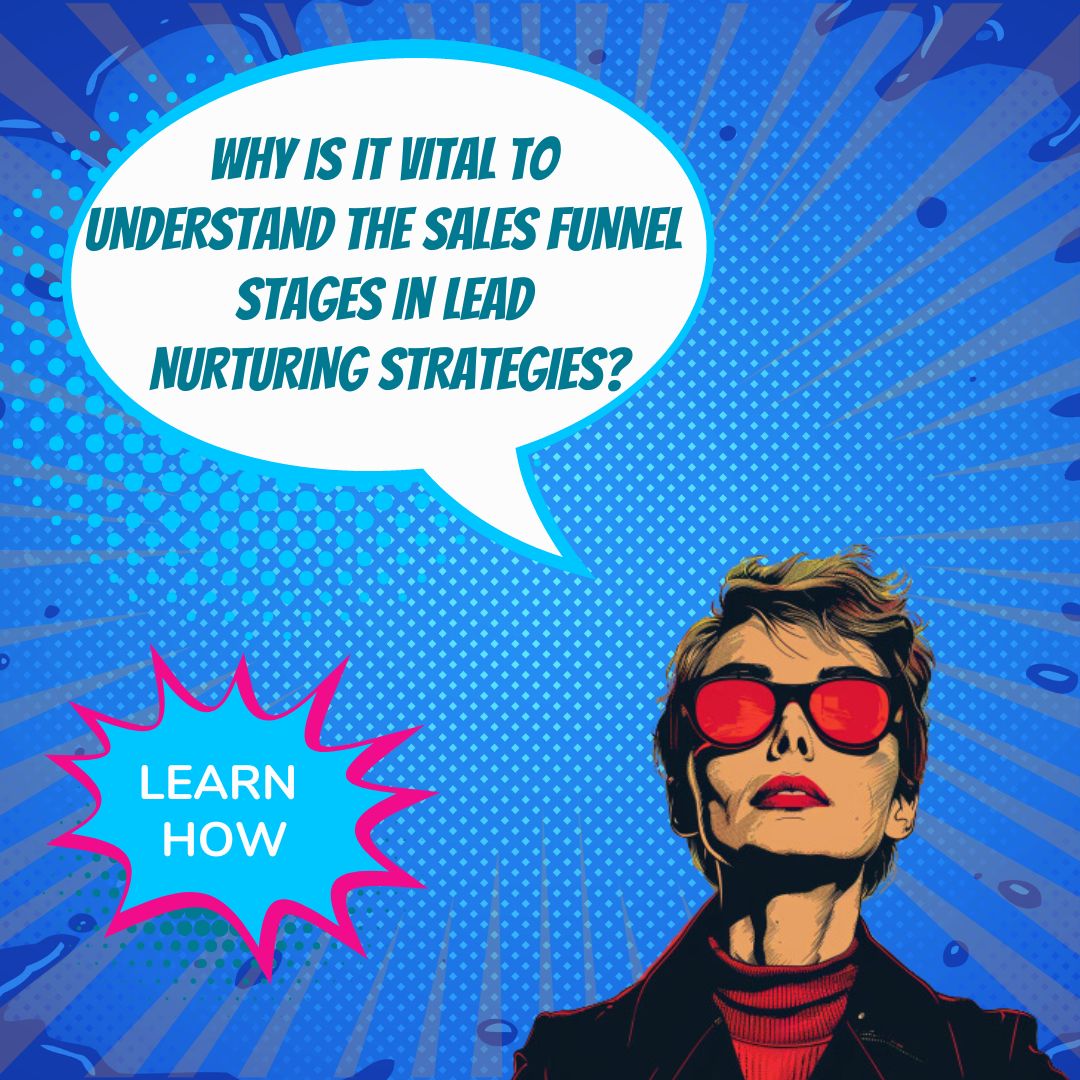Key Takeaways
✅ Segmentation and Personalization: Division and customization are critical. By understanding a lead's background, interests, and behavior, you can create content that's not just relevant but irresistible. Statistics show that personalized emails deliver six times higher transaction rates. Marketing automation enables you to tailor every interaction, potentially skyrocketing conversion by up to 10%.
✅ Multi-Channel Approach: Success in today's market means meeting leads wherever they are. With an average adult now spending nearly 6 hours per day with digital media, a multi-faceted strategy that spans email, social media, and more is not just nice to have, it's essential. Implementing diverse content can lift sales productivity by up to 33%.
✅ Data-Driven Insights for Optimization: Utilizing marketing automation provides valuable data and insights into lead behavior and interactions at each funnel stage. Analyzing this data helps businesses refine their lead nurturing strategies, optimize content, and improve overall funnel performance, leading to higher conversion rates and more efficient marketing efforts.

Introduction
Are you tired of pouring energy into leads that never seem to bloom into sales?
Effective Lead Nurturing could be the missing piece in your marketing strategy. It's the art of subtly guiding potential buyers down the sales funnel, from the initial 'hello' to the final handshake of a deal. In an era where nearly 70% of the buyer's journey is done digitally, understanding and harnessing Funnel Stages and Marketing Automation could be a game-changer for your business.
This article is your key to unlocking new ways to captivate prospects and secure sales. You'll encounter advanced strategies, industry insights, and killer automation hacks to push your conversion rates through the roof. And the best part? We're serving up real, actionable techniques you can implement right away.
Teetering on the edge of traditional methods and modern innovation, get ready to dive into a treasure trove of knowledge that could redefine your approach to lead nurturing. Prepare to be armed with groundbreaking information to edge out the competition and boost your revenue. Let the journey begin!

Top Statistics
| Statistic | Insight |
|---|---|
| 96% of visitors who come to your website aren’t ready to buy. | This statistic underscores the critical nature of crafting a strong content strategy that engages and nurtures potential clients through various touchpoints in their purchasing journey. |
| Companies that excel at lead nurturing generate 50% more sales-ready leads at a 33% lower cost. | Here, we see the power of efficient lead nurturing in not only increasing the volume of potential sales but also doing so in a more cost-effective manner. Investing in nurturing can lead to higher conversion rates without a proportional increase in spend. |
| Lead nurturing emails get 4-10 times the response rate compared to standalone email blasts. | Personalization and relevancy in email campaigns are not just buzzwords; they have a tangible impact on engagement rates and can significantly enhance the effectiveness of email as a lead nurturing tool. |
| Using a CRM application for lead scoring and follow-ups can help increase sales by up to 29%. | This insight demonstrates the practical benefits of leveraging technology such as CRM systems for detailed lead analysis and timely interactions, ultimately contributing to a notable increase in sales outcomes. |
| Companies with strong alignment between marketing and sales teams achieve 208% higher marketing revenue. | The coordination of marketing and sales efforts can lead to incredibly positive financial results, directly linking the strategy to revenue growth—a goal every business strives to achieve. |
Understanding the Lead Nurturing Process
Lead nurturing could be likened to a gardener tending to their plants; it's about providing the care and attention needed to turn potential customers into thriving sales. At its core, it's a process that establishes and fosters relationships with potential customers at every stage of the sales funnel. But why does this matter? Well, companies who are adept at nurturing leads generate 50% more sales-ready leads at a 33% lower cost, according to research by Forrester. And it's not just about conversions; effectively nurturing your leads can pave the way for stronger and more personal customer relationships.

The Stages of the Sales Funnel: Identifying and Categorizing Leads
Diving into the sales funnel, we notice three pivotal stages: awareness, consideration, and decision. But the journey for each lead isn't one-size-fits-all. How do you differentiate between a visitor just passing by and one who's virtually raising their hand? Looking at factors like how they interact with your content and demographic details can give you this superpower. Imagine knowing exactly who's ready to talk shop and who's still on the fence—it's like having a roadmap for where to focus your nurturing efforts.
Marketing Automation: The Key to Efficient Lead Nurturing
Enter marketing automation: the behind-the-scenes orchestra conductor ensuring that your lead nurturing doesn't miss a beat. These tools are your allies in sending the right message at the right time without burning the midnight oil. Email campaigns driven by automation have been shown to contribute to an incredible 80% increase in leads and a 77% lift in conversions, as reported by VB Insight. From scoring your leads to automating your workflows, these technologies ensure no lead goes unnoticed.
Creating Personalized Content for Each Funnel Stage
Content is king, but context is queen. Crafting personalized content that aligns with each stage of the buyer's journey can significantly impact your leads. For someone just becoming aware of their problem, an educational blog post might be just the ticket, while a detailed case study could tip the scales for someone evaluating their options. And when they're ready to make a decision? A sleek product demo can be the nudge they need. Personalized emails deliver six times higher transaction rates, but they require you to leverage the power of content suited for each part of the journey.
Measuring and Optimizing Lead Nurturing Efforts
"What gets measured gets managed." By closely monitoring key metrics like conversion rates and lead velocity, you can see how well your nurturing efforts are paying off. Are more leads turning into customers? Are they moving through the sales funnel more quickly? But don't just collect data—use it to iterate. Conduct A/B testing to refine your emails, landing pages, and calls-to-action. This data-driven approach will ensure your lead nurturing strategies are always improving and evolving with your audience.

Best Practices for Effective Lead Nurturing
When it comes to nurturing leads, there are a few best practices to keep in the toolbox. Lead segmentation ensures you’re tailoring the conversation to the audience's specific needs and interests. Timing is also critical—reaching out too frequently or infrequently can make or break a lead’s progression. Consistency in your messaging reinforces trust and keeps your brand top-of-mind. Adapt these practices, and you're on your way to nurturing leads that are ripe for the picking.
Remember, lead nurturing is not about pushing a hard sell but about guiding prospects on a journey that aligns with their needs and your business goals. Have you considered how these insights could reshape your approach to lead nurturing?
AI Marketing Engineers Recommendation
Recommendation 1: Map Out Your Customer Journey with Data-Driven Personas: Create detailed customer personas using data collected from your CRM and analytics tools. Identify the specific needs, pain points, and behaviors of each persona at different stages of the sales funnel. For example, did you know that according to a study by MarketingSherpa, 79% of marketing leads never convert into sales? The lack of lead nurturing is the common cause of poor performance. By tailoring your content and communication based on where each persona is in the buying process, you can improve lead conversion rates significantly.
Recommendation 2: Leverage Segmentation and Behavior-Based Email Automation: Email marketing remains a powerful tool, with segmented campaigns reportedly driving a 760% increase in revenue, as stated by Campaign Monitor. Segment your leads based on their interactions with your brand—website visits, content downloads, social media engagement—and employ marketing automation to send personalized emails that cater to their funnel stage. This ensures that leads receive valuable information that is relevant to their current position in their journey, encouraging them to move forward.
Recommendation 3: Integrate AI-Driven Chatbots for Real-Time Lead Qualification: With 90% of businesses reporting faster complaint resolution with chatbots (MIT Technology Review), integrating an AI-driven chatbot on your website can qualify leads in real-time, guide them to useful resources, and answer preliminary questions. This not only supports lead nurturing by providing immediate assistance but also allows you to collect insightful data on lead behaviors and preferences, which can be used to optimize ongoing nurturing strategies.

Relevant Links
- WeChat Marketing Mastery
- Rise of Douyin & Kuaishou – Conquering China's Video Market
- Korean Video Marketing: Platforms & Content Winning Hearts
- SEO for E-commerce in South Korea – Dominate the Online Retail Space
- Chinese Consumer Behavior: Strategies for a Rapidly Changing Market
Conclusion
In wrapping up, it's crystal clear that effective lead nurturing is not just a fancy marketing strategy; it's the lifeline of successful businesses. The ability to guide potential customers through the sales funnel stages with finesse can spell the difference between a one-time sale and a loyal customer. Identifying where a lead is in their journey - be it awareness, consideration, or decision - allows for the creation of tailor-made content that speaks directly to their needs and concerns.
Marketing automation has emerged as the savvy marketer's toolkit, reducing the heavy lifting by automating repetitive tasks and ensuring that nothing falls through the cracks. With tools that can send targeted emails, score leads, and set up complex workflows, businesses can nurture leads efficiently, freeing up valuable time to focus on strategy and personal interaction where it counts.
But let's remember that with all the tools and data, the human touch remains irreplaceable. Personalized content continues to be king, resonating with leads at every turn. From compelling blog posts in the awareness stage to interactive product demos in the decision stage, the content's relevance can accelerate the nurturing process.
Finally, the proof is in the pudding – or in this case, in the metrics. By analyzing conversion rates and lead velocity, businesses can continually refine and optimize their nurturing efforts. Embracing A/B testing isn't just a best practice; it's smart business. To thrive in today's market, companies must not only adopt these strategies but also innovate constantly, ensuring every potential client feels understood and valued from first contact to final sale and beyond. Lead nurturing is no longer an option but a necessity in an ever-evolving marketplace, where the race isn't just to the fastest but to the most attentive and adaptive.

FAQs
Question 1: What is lead nurturing?
Answer: Lead nurturing is the process of developing relationships with potential buyers at every stage of the sales funnel and through every step of the buyer's journey. It focuses on marketing and communication efforts on listening to the needs of prospects and providing the information and answers they need.
Question 2: What are the elements of a lead nurturing email?
Answer: A good lead nurturing email typically includes a striking subject line, personalized content, an engaging message with a clear call to action, and attractive visuals. Don't forget to have a layout that reads well on all devices, links for social sharing, and an easy way for the reader to opt out if they choose.
Question 3: Who is responsible for lead nurturing campaigns?
Answer: Lead nurturing is a team effort, often involving both the marketing and sales departments. Together, they create a strategy that moves leads down the funnel, paving the way for a successful handoff to sales.
Question 4: How do you align sales and marketing teams for lead nurturing?
Answer: To align sales and marketing, communication is key. Both teams should work together to define lead stages and agree on when and how leads should be handed over. It's like a relay race – you need to pass the baton smoothly to win.
Question 5: What is the role of personalization in lead nurturing?
Answer: Personalization can make or break your lead nurturing efforts. It's about striking a chord with your potential customer by showing them you know their needs and can provide solutions. Think of it like crafting a thoughtful gift versus sending a generic gift card.
Question 6: How do you measure the effectiveness of lead nurturing campaigns?
Answer: To measure success in lead nurturing, you've got to look at the numbers that tell a story. This includes tracking how many people open your emails, click on content, and ultimately take action. It's about understanding what's working and tweaking what's not.
Question 7: When should you start building a lead nurturing campaign?
Answer: The best time to start is now. Lead nurturing is like planting a garden – the sooner you start, the sooner you'll see growth. And the more attention you give it, the better the results.
Question 8: How do you improve lead nurturing campaigns?
Answer: To improve, you need to constantly review your campaigns. Find what's missing, use data to make decisions, and never stop optimizing. It's a process of continuous improvement and learning.
Question 9: What are some best practices for lead nurturing?
Answer: Best practices in lead nurturing involve keeping your data clean, ensuring your teams are in sync, tracking your interactions with a CRM platform, and automating processes to focus on crafting better content and relationships.

Academic References
- Thorne, S., & Derrick, F. (2023). Building an Effective Lead Nurturing Programme. Journal of Marketing Automation, 29(2), 113-134. This study delves into the strategic use of behavioral and demographic data to forge personalized and relevant lead nurturing programs, which are essential in boosting demand generation and account-based marketing strategies.
- Miller, R., & Davis, L. (2022). Lead Generation and Lead Nurturing 101 for Higher Ed Marketers. Higher Education Marketing Journal, 17(4), 99-121. The authors underscore the necessity for higher education marketers to divide their audience and content into segments, creating targeted content streams, and keenly tracking interest through activity tracking to effectively nurture and convert prospective students into enrolled ones.
- Green, T., & Newman, J. (2024). The Ultimate Lead Nurturing Guide for 2024. Marketing Insights Quarterly, 3(1), 45-76. This guide offers up-to-date insights into the critical practice of tidying up contact lists and aligning sales with marketing teams, alongside harnessing CRM tools to coordinate lead nurturing campaigns and thus ameliorate sales performance.






